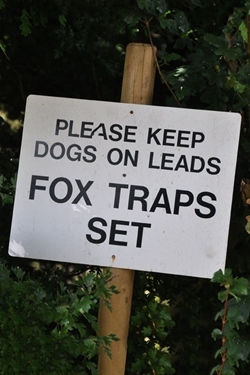Q: What other methods match the utility of snares?
 A: None. Whilst there are other methods of fox control, they may not be effective when the vegetation is tall in the spring and summer.
A: None. Whilst there are other methods of fox control, they may not be effective when the vegetation is tall in the spring and summer.
Q: What about rifle shooting or other live traps?
A: These are the only lawful alternatives for lethal control (although non-lethal methods like electric fencing also have their place). Whilst technology is allowing these techniques to change, they are still no match for all scenarios. For effective fox control in a variety of situations it is desirable to have a range of methods available, giving options according to cost, time, safety, landscape and seasonal constraints.
Q: Can foxes be trapped in other ways?
A: Cage traps are suited to use in urban environments, but are generally not very successful in rural settings. They have been formally assessed for rural foxes in Spain, but had a low success rate and were not very selective, taking lots of non-target animals including raptors. There is also a Collarum trap, which, when triggered, throws a heavy snare over the fox’s head to restrain it; these do pass humaneness standards but also have low efficiency.
Q: Why don’t these other traps work as well as snares?
A: Foxes are intuitively wary about approaching anything ‘new’, and this makes it necessary to tempt them with bait, which also raises the risk of non-target captures. By contrast, snares catch the fox completely unawares, do not require the use of bait, and have a higher catch rate when skilfully used.
Q: Couldn’t you flush the foxes out into the open or use scent lures to make shooting possible?
A: Because the foxes are fully aware that something is happening, flushing and attracting tend to select younger, more naïve foxes. To control predation pressure in the spring and summer it is necessary to catch older foxes that have reached breeding age.
Q: Can we expect other developing techniques to replace snares?
A: There is a lot of technology being brought into fox control. For example, advances in night vision, thermal imaging equipment, and acoustic attractants are making it easier to shoot foxes safely and selectively from high-seats. However, at present no other method matches the utility of snares in spring and summer conditions.
Q: If foxes trapped in snares are going to be shot, why bother using snares in the first place?
A: Shooting foxes with a rifle can be impractical during the spring and summer, when natural vegetation and arable crops are tall enough to hide a fox. Also, a gun must have someone present to work it, whereas snares work 24 hours a day to catch and hold the fox. A snare must be inspected daily so that if a fox has been caught it can be humanely shot.
Q: Why do conservationists need to control foxes in the spring and summer?
A: The fox breeding season coincides, naturally enough, with that of their prey. The food demands of growing cubs are far greater than the maintenance requirements of adults. So to protect prey species that are especially vulnerable to fox predation, like ground-nesting birds, fox control in spring and summer is critical.